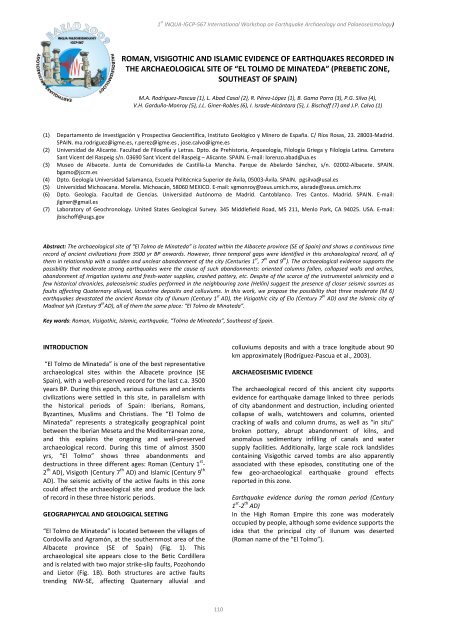Archaeoseismology and Palaeoseismology in the Alpine ... - Tierra
Archaeoseismology and Palaeoseismology in the Alpine ... - Tierra
Archaeoseismology and Palaeoseismology in the Alpine ... - Tierra
Create successful ePaper yourself
Turn your PDF publications into a flip-book with our unique Google optimized e-Paper software.
1 st INQUA‐IGCP‐567 International Workshop on Earthquake Archaeology <strong>and</strong> <strong>Palaeoseismology</strong>)<br />
ROMAN, VISIGOTHIC AND ISLAMIC EVIDENCE OF EARTHQUAKES RECORDED IN<br />
THE ARCHAEOLOGICAL SITE OF “EL TOLMO DE MINATEDA” (PREBETIC ZONE,<br />
SOUTHEAST OF SPAIN)<br />
M.A. Rodríguez‐Pascua (1), L. Abad Casal (2), R. Pérez‐López (1), B. Gamo Parra (3), P.G. Silva (4),<br />
V.H. Garduño‐Monroy (5), J.L. G<strong>in</strong>er‐Robles (6), I. Israde‐Alcántara (5), J. Bischoff (7) <strong>and</strong> J.P. Calvo (1)<br />
(1) Departamento de Investigación y Prospectiva Geocientífica, Instituto Geológico y M<strong>in</strong>ero de España. C/ Ríos Rosas, 23. 28003‐Madrid.<br />
SPAIN. ma.rodriguez@igme.es, r.perez@igme.es , jose.calvo@igme.es<br />
(2) Universidad de Alicante. Facultad de Filosofía y Letras. Dpto. de Prehistoria, Arqueología, Filología Griega y Filología Lat<strong>in</strong>a. Carretera<br />
Sant Vicent del Raspeig s/n. 03690 Sant Vicent del Raspeig – Alicante. SPAIN. E‐mail: lorenzo.abad@ua.es<br />
(3) Museo de Albacete. Junta de Comunidades de Castilla‐La Mancha. Parque de Abelardo Sánchez, s/n. 02002‐Albacete. SPAIN.<br />
bgamo@jccm.es<br />
(4) Dpto. Geología Universidad Salamanca, Escuela Politécnica Superior de Ávila, 05003‐Ávila. SPAIN. pgsilva@usal.es<br />
(5) Universidad Michoacana. Morelia. Michoacán, 58060 MEXICO. E‐mail: vgmonroy@zeus.umich.mx, aisrade@zeus.umich.mx<br />
(6) Dpto. Geología. Facultad de Ciencias. Universidad Autónoma de Madrid. Cantoblanco. Tres Cantos. Madrid. SPAIN. E‐mail:<br />
jlg<strong>in</strong>er@gmail.es<br />
(7) Laboratory of Geochronology. United States Geological Survey. 345 Middlefield Road, MS 211, Menlo Park, CA 94025. USA. E‐mail:<br />
jbischoff@usgs.gov<br />
Abstract: The archaeological site of “El Tolmo de M<strong>in</strong>ateda” is located with<strong>in</strong> <strong>the</strong> Albacete prov<strong>in</strong>ce (SE of Spa<strong>in</strong>) <strong>and</strong> shows a cont<strong>in</strong>uous time<br />
record of ancient civilizations from 3500 yr BP onwards. However, three temporal gaps were identified <strong>in</strong> this archaeological record, all of<br />
<strong>the</strong>m <strong>in</strong> relationship with a sudden <strong>and</strong> unclear ab<strong>and</strong>onment of <strong>the</strong> city (Centuries 1 st , 7 th <strong>and</strong> 9 th ). The archaeological evidence supports <strong>the</strong><br />
possibility that moderate strong earthquakes were <strong>the</strong> cause of such ab<strong>and</strong>onments: oriented columns fallen, collapsed walls <strong>and</strong> arches,<br />
ab<strong>and</strong>onment of irrigation systems <strong>and</strong> fresh‐water supplies, crashed pottery, etc. Despite of <strong>the</strong> scarce of <strong>the</strong> <strong>in</strong>strumental seismicity <strong>and</strong> a<br />
few historical chronicles, paleoseismic studies performed <strong>in</strong> <strong>the</strong> neighbour<strong>in</strong>g zone (Hellín) suggest <strong>the</strong> presence of closer seismic sources as<br />
faults affect<strong>in</strong>g Quaternary alluvial, lacustr<strong>in</strong>e deposits <strong>and</strong> colluviums. In this work, we propose <strong>the</strong> possibility that three moderate (M 6)<br />
earthquakes devastated <strong>the</strong> ancient Roman city of Ilunum (Century 1 st AD), <strong>the</strong> Visigothic city of Elo (Century 7 th AD) <strong>and</strong> <strong>the</strong> Islamic city of<br />
Mad<strong>in</strong>at Iyih (Century 9 th AD), all of <strong>the</strong>m <strong>the</strong> same place: “El Tolmo de M<strong>in</strong>ateda”.<br />
Key words: Roman, Visigothic, Islamic, earthquake, “Tolmo de M<strong>in</strong>ateda”, Sou<strong>the</strong>ast of Spa<strong>in</strong>.<br />
INTRODUCTION<br />
“El Tolmo de M<strong>in</strong>ateda” is one of <strong>the</strong> best representative<br />
archaeological sites with<strong>in</strong> <strong>the</strong> Albacete prov<strong>in</strong>ce (SE<br />
Spa<strong>in</strong>), with a well‐preserved record for <strong>the</strong> last c.a. 3500<br />
years BP. Dur<strong>in</strong>g this epoch, various cultures <strong>and</strong> ancients<br />
civilizations were settled <strong>in</strong> this site, <strong>in</strong> parallelism with<br />
<strong>the</strong> historical periods of Spa<strong>in</strong>: Iberians, Romans,<br />
Byzant<strong>in</strong>es, Muslims <strong>and</strong> Christians. The “El Tolmo de<br />
M<strong>in</strong>ateda” represents a strategically geographical po<strong>in</strong>t<br />
between <strong>the</strong> Iberian Meseta <strong>and</strong> <strong>the</strong> Mediterranean zone,<br />
<strong>and</strong> this expla<strong>in</strong>s <strong>the</strong> ongo<strong>in</strong>g <strong>and</strong> well‐preserved<br />
archaeological record. Dur<strong>in</strong>g this time of almost 3500<br />
yrs, “El Tolmo” shows three ab<strong>and</strong>onments <strong>and</strong><br />
destructions <strong>in</strong> three different ages: Roman (Century 1 st ‐<br />
2 th AD), Visigoth (Century 7 th AD) <strong>and</strong> Islamic (Century 9 th<br />
AD). The seismic activity of <strong>the</strong> active faults <strong>in</strong> this zone<br />
could affect <strong>the</strong> archaeological site <strong>and</strong> produce <strong>the</strong> lack<br />
of record <strong>in</strong> <strong>the</strong>se three historic periods.<br />
GEOGRAPHYCAL AND GEOLOGICAL SEETING<br />
“El Tolmo de M<strong>in</strong>ateda” is located between <strong>the</strong> villages of<br />
Cordovilla <strong>and</strong> Agramón, at <strong>the</strong> sou<strong>the</strong>rnmost area of <strong>the</strong><br />
Albacete prov<strong>in</strong>ce (SE of Spa<strong>in</strong>) (Fig. 1). This<br />
archaeological site appears close to <strong>the</strong> Betic Cordillera<br />
<strong>and</strong> is related with two major strike‐slip faults, Pozohondo<br />
<strong>and</strong> Lietor (Fig. 1B). Both structures are active faults<br />
trend<strong>in</strong>g NW‐SE, affect<strong>in</strong>g Quaternary alluvial <strong>and</strong><br />
110<br />
colluviums deposits <strong>and</strong> with a trace longitude about 90<br />
km approximately (Rodríguez‐Pascua et al., 2003).<br />
ARCHAEOSEISMIC EVIDENCE<br />
The archaeological record of this ancient city supports<br />
evidence for earthquake damage l<strong>in</strong>ked to three periods<br />
of city ab<strong>and</strong>onment <strong>and</strong> destruction, <strong>in</strong>clud<strong>in</strong>g oriented<br />
collapse of walls, watchtowers <strong>and</strong> columns, oriented<br />
crack<strong>in</strong>g of walls <strong>and</strong> column drums, as well as “<strong>in</strong> situ”<br />
broken pottery, abrupt ab<strong>and</strong>onment of kilns, <strong>and</strong><br />
anomalous sedimentary <strong>in</strong>fill<strong>in</strong>g of canals <strong>and</strong> water<br />
supply facilities. Additionally, large scale rock l<strong>and</strong>slides<br />
conta<strong>in</strong><strong>in</strong>g Visigothic carved tombs are also apparently<br />
associated with <strong>the</strong>se episodes, constitut<strong>in</strong>g one of <strong>the</strong><br />
few geo‐archaeological earthquake ground effects<br />
reported <strong>in</strong> this zone.<br />
Earthquake evidence dur<strong>in</strong>g <strong>the</strong> roman period (Century<br />
1 st ‐2 th AD)<br />
In <strong>the</strong> High Roman Empire this zone was moderately<br />
occupied by people, although some evidence supports <strong>the</strong><br />
idea that <strong>the</strong> pr<strong>in</strong>cipal city of Ilunum was deserted<br />
(Roman name of <strong>the</strong> “El Tolmo”).



